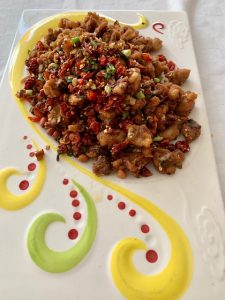

SHANGRI-La is the name of an imaginary paradise on earth, a resort of bliss, delight and peace, isolated from the world. It’s also the name of many restaurants around the world, and a multi-national hospitality company, Shangri-La Hotels and Resorts, that offers access to a Golden Circle with a world of benefits and privileges.

Kung Pao stir fried chicken with Szechuan pepper.
When Shangri-La Restaurant at 155 Enterprise Road opened several years ago, it may not have been an earthly paradise, but the garden was attractive and tranquil, management efficient and the delicacies created by a team of chefs from China made the restaurant an instant success. Following the outbreak of Covid-19, Shangri-La closed it’s doors, and like many other restaurants in Harare, created a brisk trade in take away meals.
Now that dine-in customers are being welcomed back, restaurants need to make customers feel safe and comfortable about eating out. In Wuhan, the Chinese city where the first outbreak of the virus was reported, restaurants are using live-streaming channels showing models eating in their outlets, to persuade skittish customers that it’s safe to come back. In Harare, attention to detail varies. In some places social-distancing is observed, dedicated staff are employed to take temperatures and offer sanitiser, and tables and floors are kept scrupulously clean. In other outlets nothing more than an unattended bottle of sanitiser sits at the entrance and little effort is made to greet arrivals or to make them feel welcome.
After reading on Facebook that Shangri-La was again open for sit-ins, we arrived unannounced for lunch last Saturday, the last day of October. The garden, as usual, was immaculate. A handsome peacock strutted on green lawns, displaying its brilliantly-coloured tail feathers to an admiring bevy of peahens, while a tame white rabbit lolloped happily among flowering shrubs. The verandah, however, was deserted, apart from a student practising English pronunciation with an online language course.
Before long, a pleasant waiter wearing a mask seated us at a table for two. He willingly agreed to change the creased table cloth, returning with a threadbare replacement. There were no overlays, no table mats and no table napkins.
While we waited, numerous patrons arrived to collect take-aways, and one or two large parties, dressed for a celebration, went inside presumably to private rooms.
We ordered some classic dishes from the Chinese menu, and after a fairly long wait, all three arrived at once, attractively presented on pretty serving dishes. Star of the dishes was Kung Pao chicken, a popular dish from the hot and humid Szechuan Province in China. A dry, stir fried dish of chicken, peanuts and chilli peppers, flavoured with Szechuan pepper, Kung Pao has a wild and perfumed aroma. It is also deliciously addictive and is best eaten in small quantities, mixed with plain, steamed white rice. Szechuan peppercorns create a tingling and numbing reaction on the tongue, and the effect on the taste buds is almost electric.
 Pigs ears don’t feature in mainstream Zimbabwean culture, but having seen them prepared on several cookery programmes on TV, I had an idea that they would be pretty good to eat. So my next choice off the Chinese menu was ‘sauteed pig’s ear with dried tofu slices’. I imagined the pig ear being boiled or poached until tender, and then fried crispy, the skin crunchy and the inner layers of cartilage chewy and flavourful. Although the dish was garnished with red chillis and green spring onions, looked attractive and was presented on a stylishly decorated platter, the taste was disappointing. The pigs ear was thinly sliced and limp, and the tofu lacking in flavour. This is considered a popular dish, but I won’t be trying it again.
Pigs ears don’t feature in mainstream Zimbabwean culture, but having seen them prepared on several cookery programmes on TV, I had an idea that they would be pretty good to eat. So my next choice off the Chinese menu was ‘sauteed pig’s ear with dried tofu slices’. I imagined the pig ear being boiled or poached until tender, and then fried crispy, the skin crunchy and the inner layers of cartilage chewy and flavourful. Although the dish was garnished with red chillis and green spring onions, looked attractive and was presented on a stylishly decorated platter, the taste was disappointing. The pigs ear was thinly sliced and limp, and the tofu lacking in flavour. This is considered a popular dish, but I won’t be trying it again.
Pan-fried green chilli peppers came with their usual fiery hit. Full of flavour and heat, they are best eaten in moderation as a foil to blander dishes, or toned down with steamed white rice.
Conversation at our table proved difficult, as the language student repeated his exercises very loudly, over and over again, for at least an hour. Learning a foreign language is never easy, and while he had my sympathy, the words ‘Assam, Earl Grey, Darjeeling and Chamomile’ still echo loudly in my head. He never got to grips with Darjeeling, but eventually managed a fair rendition of Chamomile.
We didn’t stay for pudding, but hurried home to prepare for Halloween, when it’s thought that the spirits and souls of departed ancestors come home for a brief visit.
Bliss, delight and peace were in short supply at Shangri-La Restaurant, but there’s no reason why they can’t up their game before the festive season gets underway. Lovers of Chinese hospitality and cuisine are ready and waiting. A Matter of Taste with Charlotte Malakoff
Comments to: cmalakoff@gmail.com